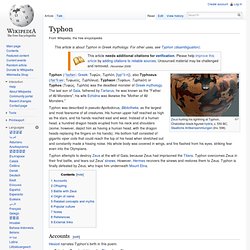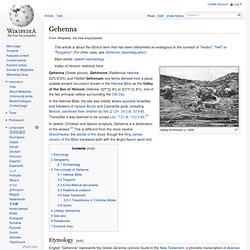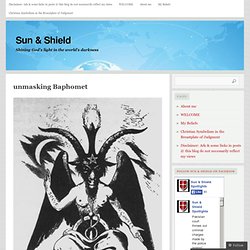

Typhon. Typhon was described in pseudo-Apollodorus, Bibliotheke, as the largest and most fearsome of all creatures.

His human upper half reached as high as the stars, and his hands reached east and west. Instead of a human head, a hundred dragon heads erupted from his neck and shoulders (some, however, depict him as having a human head, with the dragon heads replacing the fingers on his hands). His bottom half consisted of gigantic viper coils that could reach the top of his head when stretched out and constantly made a hissing noise. His whole body was covered in wings, and fire flashed from his eyes, striking fear even into the Olympians.
Accounts[edit] Hesiod narrates Typhon's birth in this poem: Gehenna. Valley of Hinnom, c. 1900 Valley of Hinnom redirects here In the Hebrew Bible, the site was initially where apostate Israelites and followers of various Ba'als and Caananite gods, including Moloch, sacrificed their children by fire (2 Chr. 28:3, 33:6).

Thereafter it was deemed to be cursed (Jer. 7:31, 19:2-6).[1] In Jewish, Christian and Islamic scripture, Gehenna is a destination of the wicked.[2] This is different from the more neutral Sheol/Hades, the abode of the dead, though the King James version of the Bible translates both with the Anglo-Saxon word Hell. Etymology[edit] Pan (god) In Greek religion and mythology, Pan (/ˈpæn/;[1] Ancient Greek: Πᾶν, Pān) is the god of the wild, shepherds and flocks, nature of mountain wilds, hunting and rustic music, and companion of the nymphs.[2] His name originates within the Ancient Greek language, from the word paein (πάειν), meaning "to pasture.

"[3] He has the hindquarters, legs, and horns of a goat, in the same manner as a faun or satyr. The History of the Devil. National Geographic - Devils Bible - Part 2. National Geographic - Devils Bible - Part 1. Baphomet. "Bahomet" redirects here.

It is not to be confused with Bahamut. The 19th century image of a Sabbatic Goat, created by Eliphas Levi. The arms bear the Latin words SOLVE (separate) and COAGULA (join together), i.e., the power of "binding and loosing" usurped from God and, according to Catholic tradition, from the ecclesiastical hierarchy acting as God's representative on Earth. The original goat pentagram first appeared in the book "La Clef de la Magie Noire" by French occultist Stanislas de Guaita, in 1897. This symbol would later become synonymous with Baphomet, and is commonly referred to as the Goat of Mendes or Sabbatic Goat.
Baphomet (/ˈbæfɵmɛt/; from Medieval Latin Baphometh, Baffometi, Occitan Bafometz) is a term originally used to describe an idol or other deity that the Knights Templar were accused of worshiping, and that subsequently was incorporated into disparate occult and mystical traditions. §History[edit] The name Baphomet comes up in several of these confessions. Unmasking Baphomet « Sun & Shield. Baphomet, the character pictured here, is a popular figure tied to many pagan rituals and organizations.

He has also been referred to as “the talking goat’s head”, “the goat of Mendes,” and “the horned god.” Because this idol has ties to so many pagan groups, no one is 100% certain who used it first. Groups throughout history who have used depictions of Baphomet in their rituals include (but are not limited to) Islamic mystics, the Knights Templar, Kabbalah, Roman pagans, Greek pagans, Druids, witches (both Wiccans and black witches), satanists, and Freemasons.
If anything, it shows that false religions have spiritual ties to each other and since they have those ties, it is no wonder that there is a push among all false religions to have a one world religion that preaches about all roads leading to “God.” The picture here of Baphomet was drawn by a man named Eliphas Levi, whose name appears in the lower part of the picture. So who is this Baphomet? Sources: Furnivall, F. Like this: Baphomet. SITEMAP.HTML SATANSERVICE.ORG SATANISM ARCHIVE (NASATANADA ZAZAS!)